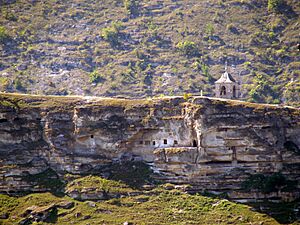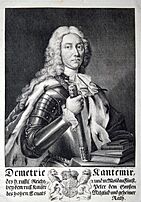Moldova facts for kids
Quick facts for kids
Republic of Moldova
Republica Moldova (Romanian)
|
|
|---|---|
|
Anthem: Limba noastră
"Our language" |
|
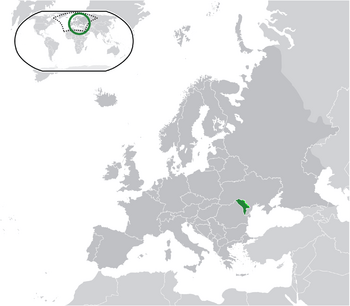
Location of Moldova in Europe (green)
and its uncontrolled territory of Transnistria (light green) |
|
| Capital and largest city
|
Chișinău 47°0′N 28°55′E / 47.000°N 28.917°E |
| Official language and national language |
Romanian |
| Recognised minority languages |
See here
|
| Ethnic groups
(2014; excl. Transnistria)
|
75% Moldovans 7% Romanians 6.57% Ukrainians 4.57% Gagauzes 4.06% Russians 1.88% Bulgarians 0.85% other |
| Religion
(2014; excl. Transnistria)
|
|
| Demonym(s) | Moldovan |
| Government | Unitary parliamentary republic |
| Maia Sandu | |
| Dorin Recean | |
|
• President of the Parliament
|
Igor Grosu |
| Legislature | Parliament |
| Formation | |
| 1346 | |
|
• Bessarabia Governorate
|
1812 |
|
• Moldavian Democratic Republic
|
15 December 1917 |
|
• Union with Romania
|
9 April 1918 |
|
• Moldavian ASSR
|
12 October 1924 |
|
• Moldavian SSR
|
2 August 1940 |
|
• Transnistria War
|
2 November 1990 |
|
• Independence from the Soviet Union
|
27 August 1991a |
|
• Constitution adopted
|
29 July 1994 |
| Area | |
|
• Incl. Transnistria
|
33,843 km2 (13,067 sq mi) (135th) |
|
• Water (%)
|
1.4 (incl. Transnistria) |
|
• Excl. Transnistria
|
30,334 km2 (11,712 sq mi) |
| Population | |
|
• January 2024 estimate
|
2,423,300 (140th) |
|
• 2014 census
|
2,804,801 |
|
• Density
|
82.8/km2 (214.5/sq mi) |
| GDP (PPP) | 2024 estimate |
|
• Total
|
|
|
• Per capita
|
|
| GDP (nominal) | 2024 estimate |
|
• Total
|
|
|
• Per capita
|
|
| Gini (2021) | ▼ 25.7 low |
| HDI (2022) | high · 86th |
| Currency | Moldovan leu (MDL) |
| Time zone | UTC+2 (EET) |
|
• Summer (DST)
|
UTC+3 (EEST) |
| Driving side | right |
| Calling code | +373 |
| ISO 3166 code | MD |
| Internet TLD | .md |
|
|
Moldova, officially known as the Republic of Moldova, is a country in Eastern Europe. It is a landlocked country, meaning it has no coastline. Moldova is located in the northeastern part of the Balkans region. It covers about 33,483 square kilometers (13,067 square miles) and has around 2.42 million people as of early 2024.
Moldova shares borders with Romania to the west and Ukraine to the north, east, and south. A region called Transnistria, which is not officially recognized by most countries, lies along Moldova's eastern border with Ukraine, across the Dniester river. Moldova is a republic with a parliamentary system of government. Its capital and largest city is Chișinău, which is also its main cultural and business center.
Moldova is one of the poorest countries in Europe. Its economy relies a lot on services. It is a member of the United Nations and other important international groups like the Council of Europe and the World Trade Organization.
Contents
Understanding Moldova's Name
The name Moldova comes from the Moldova River. This river valley was an important political center when the Principality of Moldavia was founded in 1359.
A legend says that Prince Dragoș named the river after his dog, Molda. His dog drowned in the river while they were hunting. The river's name then became the name for the whole principality.
For a short time in the 1990s, the country was sometimes called Moldavia. After the Soviet Union broke apart, the country started using its Romanian name, Moldova. The United Nations officially calls it the Republic of Moldova.
Moldova's Past: A Brief History
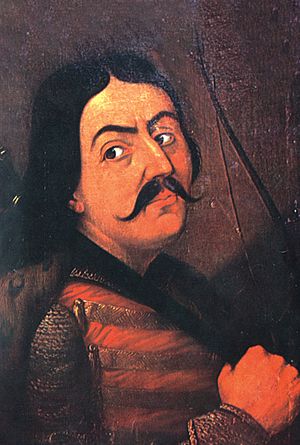
Moldova's history includes very old cultures, ancient empires, and times when other countries ruled it. It also has periods of independence.
People have lived in this area for a very long time, even 800,000 to 1.2 million years ago. Farming and pottery became important during the Stone and Bronze Ages. In ancient times, many groups like the Scythians, Goths, and Huns passed through Moldova. Later, the Roman Empire and Byzantine Empire controlled parts of it.
The Principality of Moldavia was formed in the 1350s. This was a medieval kingdom that came before modern Moldova and Romania. Famous rulers like Stephen the Great made it strong. But from 1538, it became a state that paid tribute to the Ottoman Empire.
In 1812, after a war between Russia and Turkey, the eastern part of the principality, called Bessarabia, was taken over by the Russian Empire. This started a long period of Russian influence. In 1918, Bessarabia became independent as the Moldavian Democratic Republic. It then joined Romania.
During World War II, the Soviet Union took it from Romania. It became the Moldavian SSR in 1940.
When the Soviet Union broke up in 1991, Moldova declared its independence. This was followed by the Transnistria War in 1992. This conflict led to the Transnistrian region becoming a self-governing area, though most countries do not recognize it as independent.
Moldova still has a complicated relationship between groups who want closer ties with the West and those who prefer Russia. In recent years, Moldova has been working to join the European Union. It officially applied in 2022.
In November 2020, Maia Sandu, who supports closer ties with Europe, was elected president. She was the first woman president of Moldova. She was re-elected in November 2024.
How Moldova is Governed

Moldova is a constitutional republic. This means it has a constitution that sets up its government. It has a parliamentary system with one main law-making body called the Parliament. People vote in elections to choose their leaders from different political parties.
The government has three main parts:
- The President is the head of state. They are elected every four years and can serve two terms.
- The Prime Minister is the head of government. The president chooses the prime minister, who then needs the support of the Parliament. The prime minister then forms a group of ministers called the Cabinet.
- There is also an independent judiciary, which means courts and judges are separate from the other parts of government.
The Parliament has 101 members. They are elected by popular vote every four years. The president lives in the Presidential Palace, Chișinău.
The 1994 Constitution of Moldova guides how the country is run. To change the constitution, at least two-thirds of the Parliament must agree. However, the constitution cannot be changed during war or national emergencies. Also, changes that affect the country's independence or unity must be approved by voters in a special vote called a referendum. The constitution also protects people's basic rights.
Moldova also has an independent Constitutional Court. This court has six judges who serve for six years. They check if laws and presidential decisions follow the constitution.
Joining the European Union

Moldova hopes to join the European Union by 2030.
Moldova signed an agreement with the European Union in June 2014. This agreement helps Moldova work more closely with the EU.
In March 2022, Moldova officially applied to join the EU. In June 2022, EU leaders officially made Moldova a candidate country. This means Moldova is now on the path to becoming a member. The EU is also helping Moldova make changes needed to join. The EU has said that solving the Transnistria conflict is not a requirement for Moldova to join.
In June 2023, the European Union announced a large support program for Moldova. This includes money for investments and lower prices for mobile phone services. Moldova also joined the EU's platform for buying gas together.
Official talks about joining the EU started in December 2023. Moldova plans to hold a vote in autumn 2024 to ask its citizens if they want to join the EU. People in Transnistria can travel to other parts of Moldova to vote if they wish.
In this vote, a small majority of 50.17% voted "yes" to joining the EU. President Maia Sandu said there was "unprecedented" outside interference in the vote.
Regions and Cities
Moldova is divided into 32 districts. It also has three main cities and two special self-governing areas: Gagauzia and the Left Bank of the Dniester. The status of Transnistria is still debated, as the Moldovan government does not control that area.
Moldova has 66 cities and 916 smaller towns or villages called communes. Many smaller villages are part of these cities or communes. In total, Moldova has 1,682 places where people live.
The largest city is Chișinău, with about 695,400 people. The second largest is Tiraspol (129,500 people), which is in the Transnistria region. Other large cities include Bălți (146,900) and Bender (91,000).
Moldova's Land and Nature

Moldova is a landlocked country in Eastern Europe. It is located on the northeastern edge of the Balkans, near the Black Sea Basin. It lies between Romania to the west and Ukraine to the north, east, and south.
The country's borders are 1,389 km long. The Prut river separates Moldova from Romania in the west. The Dniester river separates it from Ukraine in the east. Moldova's total land area is about 33,843.5 square kilometers (13,067 square miles). Most of the country (about 88%) is in the Bessarabia region. A narrow strip in the east is part of the Transnistria region, which is on the eastern bank of the Dniester.
Even though it's landlocked, Moldova gained a small access point to the Danube river in 1999. This allowed the village of Giurgiulești to become a river port. This port gives Moldova access to international waters through the Danube and the Black Sea. The Dniester river flows through Moldova, separating the main territory from Transnistria, and then flows into the Black Sea in Ukraine.
Most of Moldova is hilly, but the highest point, Bălănești Hill, is only about 430 meters (1,410 feet) high. Moldova's hills are part of the Moldavian Plateau, which comes from the Carpathian Mountains. The country has very rich, dark soil called Chernozem, which covers about three-quarters of its land. This soil is excellent for farming.
The capital city, Chișinău, is in the middle of the country. It is Moldova's main industrial and business center. Tiraspol is the second-largest city and the capital of the Transnistria region. Bălți is the third-largest city, often called the 'northern capital'. Comrat is the main city of the Gagauzia region.
Moldova's Climate
Moldova has a moderately continental climate. Because it is close to the Black Sea, its autumns and winters are mildly cold, and its springs and summers are relatively cool.
Summers are warm and long, with average temperatures around 20°C (68°F). Winters are mild and dry, with January temperatures averaging about -4°C (25°F). The amount of rain can change a lot, from about 600 mm in the north to 400 mm in the south. Long dry periods are common. The most rain falls in early summer and again in October, often with heavy showers and thunderstorms.
The highest temperature ever recorded in Moldova was 41.5°C (106.7°F) in July 2007. The lowest was -35.5°C (-31.9°F) in January 1963.
| Location | July (°C) | July (°F) | January (°C) | January (°F) |
|---|---|---|---|---|
| Chișinău | 27/17 | 81/63 | 1/−4 | 33/24 |
| Tiraspol | 27/15 | 81/60 | 1/−6 | 33/21 |
| Bălți | 26/14 | 79/58 | −0/−7 | 31/18 |
Animals and Plants of Moldova
Moldova is home to different types of forests and grasslands. Forests currently cover only 11% of Moldova. However, the government is working to plant more trees.
Animals like red deer, roe deer, and wild boar live in these wooded areas.
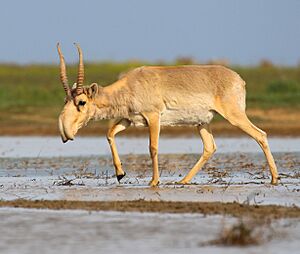
The environment in Moldova suffered a lot during the Soviet period. Industries and farms grew without much care for nature. Too many pesticides were used, polluting the soil.
The Ecological Movement of Moldova was started in 1990. This group works to help restore Moldova's natural environment.
Animals like the saiga used to live in Moldova but became extinct there in the late 1700s. They were hunted too much and their habitats were destroyed.
Another animal, the European Wood Bison (or wisent), also became extinct in Moldova in the 1700s. But in 2005, three European bison were brought from Poland to reintroduce the species. Moldova wants to increase its wisent population and has talked with Belarus about exchanging bison.
Moldova's Economy
Since Moldova became independent from the Soviet Union in 1992, it has been changing to a market economy. This means businesses are mostly privately owned, not controlled by the government.
Moldova's main exports are farm products, clothing, and sports equipment. In 2021, Moldova exported $140 million worth of wine. It is the 21st largest wine exporter in the world. The wine industry is very important to Moldova's economy. It makes up 3% of the country's total economic output (GDP) and 8% of its exports. Moldova's climate, with 300 days of sunshine a year, is perfect for growing grapes. The European Union became the main buyer of Moldovan wines in 2021.
Information and Communication Technology (ICT) is another growing part of Moldova's economy. It makes up more than 10% of the country's GDP. Over 2,000 students graduate with computer-related degrees each year. IT companies in Moldova export about 80% of their services to countries like the United States, the United Kingdom, France, and Germany.
Energy in Moldova
Moldova has very few natural energy resources. This means it has to import almost all of its energy. A Russian company called Gazprom owns 50% of Moldovagaz, Moldova's national energy company.
Visiting Moldova: Tourism
Moldova is one of the least visited countries in Europe. Because of this, tourism is not a huge part of its economy. However, even with the war in neighboring Ukraine, Moldova saw more foreign visitors in early 2022 than before the COVID-19 pandemic.
Recently, some Western media have started to show Moldova as an interesting place to visit. They highlight its beautiful landscapes, sunny weather, low prices, old wine culture, and mix of different cultures. Tourism in Moldova focuses on its natural beauty, historical places, and wine tradition.
You can fly to Moldova through Chișinău International Airport. There are direct flights to many European cities. You can also travel by train to nearby cities like Bucharest and Kyiv. Moldovan citizens can travel to the Schengen Area without a visa.
Moldova is a major wine exporter with over 142 wineries. It has the largest wine cellar in the world. Many wineries offer tours to visitors. Famous places include:
- Cricova winery, with a wine cellar stretching over 120 km (75 miles).
- Castel Mimi, a 19th-century castle with vineyards, a museum, and a hotel.
- Mileștii Mici, which has the world's largest collection of wine.
Moldova also has a long history of Eastern Orthodox Christianity. There are over 50 monasteries and 700 churches. Some famous ones are the Old Orhei Cave Monastery, which is carved into a cliff, and the 19th-century Nativity Cathedral in Chișinău.
The capital city, Chișinău, has most of the country's national museums. These include the National Museum of Fine Arts and the National Museum of History of Moldova. Every year on October 3-4, Moldova celebrates National Wine Day. On this day, wineries open their doors to the public.
Farming in Moldova
Moldova is a country that combines farming and industry. Farmland covers 2,499,000 hectares out of a total area of 3,384,600 hectares. About 1,810,500 hectares are suitable for growing crops. Moldova is one of the best countries in Europe for farming. Its Chernozem soil in the Bălți Steppe is among the most fertile in the world.
With over 300 sunny days a year, Moldova is also one of the largest wine producers globally. Moldova's farming sector benefits from being close to large markets, especially the European Union. In 2021, farming products made up 12% of Moldova's exports and 21% of its jobs.
The most exported foods are corn, wheat, sunflower seeds, grapes, and apples. Important local industries include sugar processing, vegetable oil, and food processing. Between 2015 and 2022, agricultural production almost doubled, especially for vegetables and fruits.
However, Moldova's farming faces challenges from climate change. Even though Moldova produces less greenhouse gases than many countries, it is very affected by climate change. This causes problems like droughts and floods, which cost the country about 2.13% of its annual GDP.
Getting Around: Transport
The main ways to travel in Moldova are by train and by road. The country has about 1,138 km (707 miles) of railways. Its highway system is about 12,730 km (7,910 miles long), with most of it paved. Trains connect Moldova to neighboring cities like Bucharest, Kyiv, and Odesa.
The Giurgiulești terminal on the Danube river can handle small ships that travel on the sea. Shipping on the lower Prut and Dniester rivers is not a major part of Moldova's transportation.
The only international airport in Moldova is Chișinău International Airport. It has direct flights to many European cities.
Staying Connected: Telecommunications
Internet in Moldova is known for being fast and affordable. In 2023, Moldova ranked 3rd in the world for gigabit internet coverage. About 90% of the population can get super-fast fiber-optic internet.
The United Nations Development Programme says Moldova has a very good digital system. About 98% of its territory has 4G mobile coverage. By July 2022, over 3 million people in Moldova used the internet, which is about 76% of the population. Moldova is also planning to start using 5G technology in 2024. Starlink internet also became available in Moldova in August 2022.
The Information and Communication Technology (ICT) sector is growing fast in Moldova. It makes up over 10% of the country's GDP. More than 2,000 Moldovan students graduate each year with degrees in computer-related fields.
People of Moldova
Population of Moldova according to ethnic group Moldovans (75%) Romanians (7%) Ukrainians (6.57%) Gagauzians (4.57%) Russians (4.06%) Bulgarians (1.88%) Romani (0.34%) Belarusians (0.10%) Jews (0.06%) Poles (0.05%) Germans (0.03%) Others (0.26%)
Moldova has an estimated population of about 2,423,300 people as of January 2024. Many Moldovans live in cities. About 43.4% of the population lives in urban areas. Around one-third of all Moldovans live in the capital city, Chișinău, and its surrounding area.
In 2022, the country had about 82.8 people per square kilometer. The average life expectancy was 71.5 years. There are more women than men in Moldova. Women who work tend to have higher education levels, but they still earn less than men on average. The number of older people (60 and over) is increasing each year.
The official language is Romanian. It is a Romance language, similar to French, Spanish, and Italian. About 15% of Moldovans also speak Russian.
According to the 2014 national census:
- About 75% of the population are Moldovans.
- The largest minority groups are Romanians (7%), Ukrainians (6.57%), Gagauzians (4.57%), and Russians (4.06%).
- Smaller groups include Bulgarians (1.88%), Romani (0.34%), and others.
Religion in Moldova
Moldova's constitution allows for freedom of religion. It also states that the church and state are completely separate.
According to the 2014 Moldovan census, 90% of the country's people are Eastern Orthodox Christian.
Among those who are not Orthodox Christians:
- About 7% say they have no religion.
- There are also groups like Baptists, Jehovah's Witnesses, and Pentecostals.
- The Jewish Community of the Republic of Moldova estimates about 20,000 Jewish people live there.
- The Islamic League of Moldova estimates about 15,000–17,000 Muslims.
- There are several synagogues and one mosque in Chișinău.
Other smaller groups include Seventh-day Adventists, Evangelical Christians, Roman Catholics, and Lutherans.
Moldovan Culture
Moldova's culture is mostly shaped by its Romanian roots. These go back to the second century AD, when the Roman Empire colonized the area called Dacia. Moldova is located where Latin, Slavic, and other cultures meet. This has allowed it to adopt and keep traditions from neighboring regions.
The largest ethnic group, who identified as "Moldovan" by the 14th century, played a big role in forming classical Romanian culture. The culture was also influenced by Byzantine culture, and later by the Ottoman Turks. In the 19th century, Western European ideas strongly influenced Moldovan literature and art. During periods of Russian and Soviet rule (1812–1917 and 1944–89), Moldovans were also influenced by Russian culture.
Moldova's cultural heritage includes many churches and monasteries. These were built by the ruler Stephen the Great in the 15th century. Important scholars like Dimitrie Cantemir also shaped the culture.
Mihai Eminescu, a famous poet, and Ion Creangă, a writer, are considered national writers in both Romania and Moldova.
Moldovan Food
Moldova's rich soil produces many grapes, fruits, vegetables, grains, meat, and milk products. All of these are used in the national cuisine. The fertile black soil and traditional farming methods allow for a wide variety of foods to grow.
Moldovan food is similar to that of neighboring Romania, Ukraine, and Poland. They share many traditional dishes, often with small regional differences. Historically, Moldovan cuisine has been influenced by Russian, Turkish, and Ukrainian cooking.
Main dishes often include beef, pork, potatoes, cabbage, and different cereals. Popular alcoholic drinks are divin (Moldovan brandy), beer, and wine. Moldova is known for making high-quality wines.
Here are some traditional Moldovan dishes:
- Plăcinte are fried pastries with fillings like cheese, cabbage, potatoes, or fruit. They can be sweet or savory.
- Sarmale are cabbage leaves stuffed with rice, vegetables, and meat. They are baked in oil.
- Mămăligă is a type of porridge made from yellow corn flour. It is often served with sheep's cheese and sour cream.
- Zeamă is a thin chicken soup made with homemade noodles and vegetables.
- Brynza is a soft sheep or goat cheese. It is used in salads, pies, and dumplings.
Borscht, a sour soup made from beetroots, is also popular. Pierogi (called chiroște in Moldova) are another traditional food. They are often stuffed with soft cheese. Medovik, a layered cake with honey and sour cream, is a popular dessert.
Holidays and Celebrations
Most stores are closed on New Year's Day and Independence Day. But they stay open on other holidays. Christmas is celebrated on either January 7th (the traditional date for some Orthodox churches) or December 25th. Both dates are public holidays.
On March 1st, people celebrate mărțișor. This is a tradition where women are given a special talisman for good luck.
Music and Arts

Some of Moldova's most famous composers are Gavriil Musicescu and Eugen Doga.
In pop music, the band O-Zone became famous in 2003 with their hit song "Dragostea Din Tei". Moldova has been in the Eurovision Song Contest since 2005. Another popular band, Zdob și Zdub, represented Moldova in 2005 and 2021.
The band SunStroke Project also represented Moldova in 2010 and 2017. Their saxophonist, Sergey Stepanov, became an internet meme known as "Epic Sax Guy" because of his dancing.
In 2015, a new music project called Carla's Dreams became very popular. They reached top charts in Europe with their song "Sub Pielea Mea" in 2016. The group performs with painted faces and keeps their identities secret.
Famous classical musicians from Moldova include opera singer Maria Bieșu and pianist Mark Zeltser.
Sports and Games

Football is the most popular team sport in Moldova. The Moldovan Football Federation manages football in the country. The Moldova national football team played its first match in 1994. However, it has never qualified for the UEFA European Championship.
The most successful football club is Sheriff Tiraspol. It is the first and only Moldovan club to play in the group stages of the UEFA Champions League and the UEFA Europa League. Other successful clubs include Zimbru Chișinău and Milsami Orhei.
Trîntă, a type of wrestling, is the national sport in Moldova. Rugby union is also popular. More than 10,000 fans attend international rugby matches.
In chess, Moldova has several international masters, such as Viorel Iordăchescu and Viorel Bologan.
Moldovan athletes have won medals in various sports. These include athletics, judo, swimming, weightlifting, and wrestling. Moldova first participated in the Olympics at the 1994 Winter Olympics. Olympic medalists include Sergei Mureiko and Serghei Tarnovschi.
Images for kids
See also
 In Spanish: Moldavia para niños
In Spanish: Moldavia para niños





